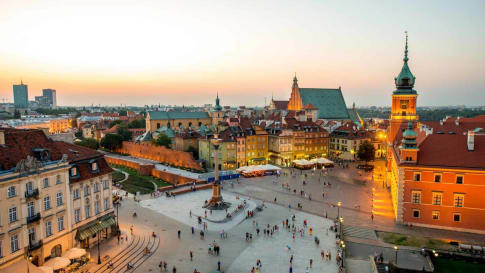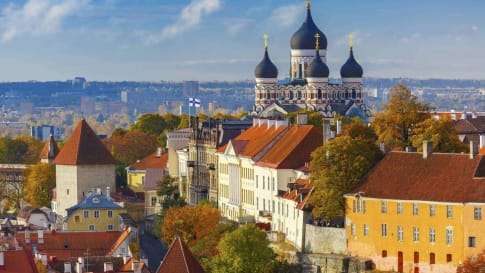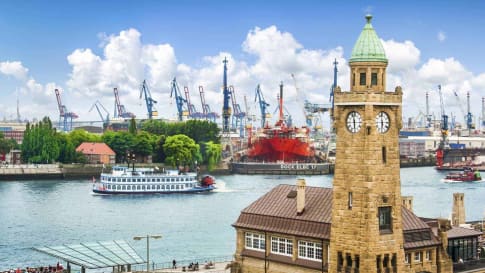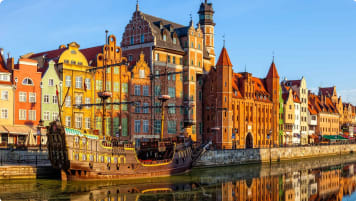Questions About Poland: The Definitive Guide for Travellers
Consider and Escorted small group tours for mature and senior travellers to Poland. Designed for couples and solo travellers who like to explore and enjoy learning as they travel to the historic sites of Poland including Warsaw , Gdansk and beyond.
14 Nov 19 · 2 mins read

Questions About Poland for seniors
Odyssey Traveller specialises in crafting unforgettable experiences for senior and mature-aged travellers interested in exploring be they couples or solo travellers. Providing adventure and educational programs to escorted small group tours for seniors since 1983. Odyssey has built up a reasonable knowledge bank to answer questions about Poland that travellers are likely to ask, as they make their plans to tour independently, or with us as part of a small group tour. We hope that this list of frequently asked questions and the answers we provide will help you with planning your next holiday.
Read on, but please do not hesitate to contact us via the website, or through email or chat if you have more questions about Poland or our other tours.


FAQs
Where is Poland located?
Poland lies at the heart of the European continent, between Western and Eastern Europe. It is bordered by the Black Sea to the north, Lithuania to the north-east, Belarus and the Ukraine to the east, Slovakia and the Czech Republic to the south, and Germany to the west.

What language do they speak in Poland?
The country’s official language is Polish. The language is closely related to the other West Slavic languages, Czech, Slovak, and a number of other little-spoken languages.
What religion is Poland?
Though Poland has no official religion, the vast majority of the population (86%) is Roman Catholic. Religious minority groups include Jewish people and Muslims.
Who founded Poland?
The terms ‘Poland’ and ‘Poles’ begin to appear in written records of European history around the 10th century. The region that would become Poland was inhabited by several tribes, led by dux (dukes). The two biggest and most powerful tribes – the Polanie and the Wiślanie – brought the other tribes under their control.
Eventually, the Wiślanie came under the rule of the first Polanie King to be mentioned in recorded history, Mieszko I. Mieszko converted Poland to Christianity, bringing the country into the fold of Western Christendom. In the 13th century, Poland became prosperous thanks to the development of salt, silver and gold mining industries. It was a vital part of Europe’s emerging trade networks, and settlers from Western Europe came to the region, attracted by the relative freedom.
In the later 14th century, Jadwiga, Queen of Poland married Jogaila, the Grand Duke of Lithuania. The marriage linked the small kingdom with Lithuania, then a large and diverse country. Though Lithuania had been pagan, Jogaila accepted Roman Catholicism for himself and his country on his marriage. In 1568, the informal alliance was further formalised with the Union of Lublin, which provided for a jointly elected grand-duke and legislature, unique in Europe.
The early 16th century is generally seen as Poland’s ‘golden age’, when arts and sciences flourished in the region. The nation developed a reputation for relative tolerance towards Jews, meaning that Poland long had Europe’s biggest Jewish population.
Why was Poland partitioned?
The Polish-Lithuanian Commonwealth was one of the largest and most diverse countries of Europe, stretching from the Baltic to the borders of Russia to the Black Sea (in modern-day Ukraine). It was inhabited not just by Poles and Lithuanians, but Ruthenians, Germans, Jews, and small numbers of Tatars, Armenians and Scots. It was also religiously diverse, with communities of Roman Catholics, Protestants, Eastern Orthodox, Jews, and Muslims living within its borders.
While most of Europe became increasingly absolutist during the Early Modern period, Poland-Lithuania maintained a system of strict checks over monarchical power by a legislature (sjem) comprised of the szlachta (nobility). Eventually the King – often from an outside country – was elected by the szlachta.
Though the Commonwealth was prosperous at first, prolonged warfare with Russia and Sweden proved destructive. Famines and epidemics followed invasions, and the population dropped from 11 to 7 million. Economically, Poland-Lithuania could no longer keep up with Western Europe. The strength of the szlachta kept the peasantry in a brutal form of serfdom, which was becoming increasingly obsolete in Western Europe.
Following wars with Lutheran Sweden and Orthodox Russia, the Polish nobility became increasingly religiously intolerant. The ideology of sarmatism, which held that the Polish nobility were descended from Iran, created a sense of Polish exclusivity and difference from the rest of Europe.
Increasingly weak, Poland was under the influence of Russia to the east and Prussia to the west. Russian troops remained in Poland, and terrorised the legislature. In response, Poles formed the Confederation of Bar to challenge Russian influence, and civil war broke out.
The result of civil war was the first partition of Poland in 1772, during which Poland lost almost one-third of its land and population to Prussia, Russia, and Austria.
In the aftermath of the First Partition, Poland experienced a cultural revival. Education was no longer totally controlled by the Jesuit order; the first manufacturing concerns developed; and the rights of the peasantry improved and serfdom was abolished in some places.
When Russia, Prussia and Austria became distracted by the French Revolution, the King met with an emerging group of revolutionary ‘patriots’, inspired by the ideas of the Enlightenment. After years of negotiation, they created Europe’s firs Enlightenment ideas influenced by the American Revolution, the King was held responsible to the legislature, as in Polish tradition. However, the legislature was now itself elected directly by the people (albeit those who met certain property requirements). Religious freedom was required and the peasantry were taken under protection of the law, though their status was not reformed much further.
This new constitution, with its moves towards the Enlightenment, was anathema to the conservative rulers of Prussia and Russia. Catherine the Great invaded Poland in 1792, defeating the outnumbered Polish troops led by Józef Antoni Poniatowski and Tadeusz Kościuszko.
In the aftermath, Russia and Prussia further seized Poland’s territory with the Second Partition of Poland. In 1794, Kościuszko raised the banner of rebellion in the rump Poland, in defiance of the King. He offered to emancipate the peasants, bringing them to his cause, but it was not enough – the insurrection was defeated by Russian and Prussian forces. Poland was divided again in 1795, marking its total obliteration from the world map.
This did not mean the end of the Polish struggle, however. Kościuszko became a hero to generations of Polish revolutionaries, who staged rebellions through the 19th century. Polish romantic composers, such as Frédéric François Chopin, composed stirring odes to the Polish cause, which inspired emergent national movements across the world. Even Australian history bears the influence of the Polish struggle for freedom. Australia’s highest mountain, Mt. Koscuiszko, was named for Kościuszko by the Polish explorer Paweł Edmund Strzelecki in 1840.
How did Poland become democratic?
While World War I would lead to the deaths of many Poles – forced to fight against one another in the armies of Russia, Germany, and Austria, the end of the war and the Treaty of Versailles would see Poland once again emerge as an independent nation. Its borders were a lot smaller than before, however, and the important city of Gdańsk was given to Germany as the ‘free city’ of Danzig.
The ‘Second Republic’ of Poland was the sixth-biggest country in Europe, with a population of around 26 million. Initially a democratic republic, it became increasingly unstable and Józef Piłsudski, a national hero of World War I, seized dictatorial control.
In 1939, Germany and the Soviet Union signed a nonaggression pact that divided Poland between the two powers. On 1 September, 1939, Nazi Germany invaded Poland, precipitating the Second World War.
Poland was devastated by both invasions. The Soviet Union deported over 1.5 million Poles to other parts of the Soviet Union. Nazi policy sought to eradicate the Polish nation, believing its territory to be Germany’s right. Hundreds of thousands of Poles were moved into forced labour camps in Germany, while the intelligentsia were executed en masse.
Even more devastating was Nazi Germany’s policy towards Polish Jews. At first, Jewish people were confined into ghettos, and then shipped off to extermination camps around the country. Around three million Polish Jews died in concentration camps – almost the country’s entire Jewish population.
When Hitler unexpectedly attacked the Soviet Union in June 1941, all of Poland came under Nazi control. The country would be devastated by the war. Over six million people had lost their lives and the cities lay in ruins.
At the end of World War II, Poland found itself within the Soviet bloc. Though formally independent, in reality Poland’s Communist government was heavily influenced by Russia.
The regime in Poland, though varying in degree, was never as repressive as in other parts of the Eastern Bloc. In 1980, workers in major ports and shipyards in Gdańsk went out on strike, challenging the increasingly exorbitant cost of living. In response, the government signed an agreement allowing workers to form independent trade unions, which organised under the national banner Solidarity (Solidarność). Solidarity included a wide range of ideologies, creating the conditions for widespread national debate about the processes and goals of reform. This proved too much for the government, and in 1981 it declared martial law, dissolved Solidarity, and imprisoned the leader of the movement, Lech Wałęsa.
While martial law meant that Solidarity could no longer function effectively, the spirit of the movement was maintained. Opposition to the regime – and belief in the potential of a democratic Poland – was also nurtured by the Catholic church. The election of Karol Cardinal Wojtyła, the Archbishop of Krakow, as Pope John Paul II in 1979 gave Poles further inspiration in the struggle for democracy.
The late 1980s saw the rise of Mikhail Gorbachev to the leadership of the Soviet Union, whose reforms led to the collapse of Communism in Eastern Europe. Solidarity, now allowed to reform, participated in partially free elections in 1989 that brought it a sweeping victory. Poland became a full democracy with the dissolution of the Warsaw Pact in 1991.
Where to go in Poland?
With a long and fascinating history and a diverse natural landscape, there are many places to visit in Poland:
Warsaw:
Poland’s capital and largest city, Warsaw has been shaped by its turbulent 700-year history. The city is home to a number of fascinating history museums, including the Museum of Warsaw and the equally impressive Praga Museum of Warsaw. For classical music lovers, the Fryderyk Chopin Museum, devoted to one of Warsaw’s most famous sons, is a must see.
Bear witness to the city’s most tragic moment at the Warsaw Rising Museum, which focuses on the 1944 Warsaw Ghetto rising against the Nazis, and learn more about Europe’s largest Jewish community and its great contribution to Polish society and culture at the POLIN Museum of the History of Polish Jews.
Though Warsaw’s Old Town was tragically destroyed by bombing during World War II, it has been reconstructed remarkably authentically, showing how it would have looked in the 17th and 18th centuries. Wilanów Palace, built by King Jan II Sobieski in 1677, is Poland’s grandest Baroque palace. Łazienki Park, a former royal hunting ground, is a treat for garden lovers. There are three main gardens, which span centuries: the 18th-century Italianate Royal Garden, the 19th century Romantic Garden and the early 20th-century Modernist Garden, home to the Art Nouveau Chopin monument.
Warsaw is also richly endowed with modern and contemporary architecture. Take a look at the Art Nouveau Hala Koszyki, an early 20th century market hall converted into a foodie hub, or the Warszawa Powiśle, a spaceship-like former ticket office now operating as a cafe. Contemporary architecture can be seen at the POLIN Museum and the Copernicus Science Centre.
Warsaw’s most divisive building will always be the Communist-era Palace of Culture and Science, a ‘gift of friendship’ from the Soviet Union completed in 1955. Reviled for decades, young Varsovians are now embracing the building as an icon of the city. Whatever your feelings about the building, make sure to head to 30th-floor observation terrace for panoramic views of the city.
Kraków:
Architecture buffs will love Kraków, Poland’s capital city until the 16th century. The Old Town combines Gothic, Renaissance, Baroque and Art Nouveau elements. Highlights include the 15th-century Town Hall Tower and the 16th -century Cloth Hall, on the Main Market Square; the Gothic St. Mary’s Basilica; and the Renaissance Wawel Royal Castle, home to Poland’s royal court through the 16th century.
Gdańsk:
The city of Gdańsk has a cosmopolitan air unique in Poland. Centuries as a major Baltic Sea port meant that the city was long home to a diverse population of merchants, while subsequently the city would move between Poland and Germany as Gdańsk/Danzig, while German-speakers would long be the majority. It’s easy to imagine the thriving medieval port when walking past narrow merchant’s houses on the Motława River waterfront. Make sure to look at the Żuraw, the largest crane in Medieval Europe.
More historic buildings can be seen around the main street, Długi Targ, and make sure to visit the Gothic St. Mary’s Church. For modern history, head to the European Solidarity Centre, a museum devoted to the history of the Solidarity strikes.
Outside the cities:
There are a number of important historical sites located outside of the cities. Malbork Castle, doable as a daytrip from Gdańsk, was the headquarters of the notorious Teutonic Knights for over 150 years. Rural Poland is dotted with wooden folk architecture known as skansen, with 120 historic buildings preserved at Sanok’s Museum of Folk Architecture. Travellers may also wish to bear witness to the horrors of the Holocaust at the Auschwitz-Birkenau Memorial and Museum.
As one of the largest countries in Europe, Poland offers an array of landscapes. The Great Masurian Lakes, in the north-east, offers an extensive system of waterways perfect for yachting and canoeing, while the south is home to the Tatra Mountains, the highest part of the Carpathians. Awe-inspiring yet accessible, the Tatras offer a number of manageable walks for inexperienced hikers.
Related Tours

21 days
Jun, Sep, May, OctExploring Poland | Poland Small Group Tour
Visiting Poland
Odyssey's European tour of Poland provides the guests with authentic experiences in a range of key historical destinations to enjoy. Your tour leader supported by knowledgeable local guides who provide daily itineraries that often take you off the beaten path to learn more about the places visited.
From A$13,340 AUD
View Tour
21 days
May, Oct, AprBaltics: Latvia, Estonia, Lithuania, Helsinki, Stockholm and Copenhagen
Visiting Denmark, Estonia
An escorted small group tour to the Baltic States of Europe that explores the key destinations of this region starting in Warsaw, then making its way through Poland, Estonia, Latvia, Lithuania, Finland, Stockholm and concluding in Copenhagen. Each day has scheduled itineraries supported by local guides who share knowledge and authentic experiences of the places visited. This is small group travelling to the Baltics for like minded people.
From A$16,975 AUD
View Tour
23 days
Jun, SepHistory of the Hanseatic League
Visiting Germany, Poland
Merchants generated much of the wealth of Europe, from Venice to Genoa, Lisbon and London. On the Baltic coast building on the Vikings, the Hanseatic league become the traders influence trade from the middle ages across Europe. This small group tour for senior couple and mature solo travellers explores the history.
From A$17,465 AUD
View Tour




